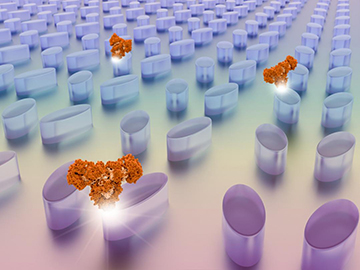
The detection platform demonstrated by scientists in Switzerland and Australia, which combines a high-Q-factor dielectric surface and hyperspectral imaging, can reportedly detect biomolecules at a density of less than three molecules per square micron of detector. [Image: EPFL]
Researchers in Switzerland and Australia have brought together the physics of dielectric metasurfaces and hyperspectral imaging to create an ultrasensitive, label-free biosensing platform (Nat. Photon., doi: 10.1038/s41566-019-0394-6).
The team believes that the platform—reportedly capable of detecting and analyzing samples at spatial concentrations of less than three molecules per square micron—could ultimately enable compact portable diagnostics for personalized medicine. It could also, according to the researchers, offer a route to high-throughput, high-resolution optical characterization of single-atom-thick, 2-D materials such as graphene, a key requirement for advancing the technical development of those much-ballyhooed materials.
The dielectric difference
Sensors that operate via surface plasmon resonances—the subwavelength concentration and amplification of light on surfaces decorated with nanoscale metallic antennas—already have a long pedigree in biomedical diagnostics. As cells or biomolecules bind to the nanostructures, they change the local refractive index by an infinitesimal amount, which in turn leads to sharp changes in the peak wavelength of the surface plasmon resonance. Those wavelength changes can be read to track the presence, concentration and growth of the biological agent under study.
In recent years, as the technology of nanofabrication has improved, interest has grown in using non-metallic, dielectric nanoparticles and metasurfaces to pull off some of the same light-localization tricks enabled by plasmonics. In particular, the use of dielectrics could avoid one particular pitfall of plasmonic surfaces: The tendency of these metal-based systems to dissipate a lot of optical energy as heat. Non-plasmonic, dielectric metasurfaces with a variety of potential nanophotonic applications have been demonstrated, many of them relying on the physics of Mie-type resonances, which allow local optical resonances to be tuned based on nanoparticle geometry and size (see “Meta-Optics with Mie Resonances,” OPN, January 2017).
Bound states in the continuum
The dielectric biosensor platform demonstrated in the new study—the work of a team led by OSA member Hatice Altug of the Ecole Polytechnique Fédérale de Lausanne (EPFL), Switzerland—relies on a different kind of resonance, enabled by so-called bound states in the continuum (BICs).
Originally a concept from quantum mechanics, BICs are confined waves that remain localized within a continuous spectrum of radiating waves. (More precisely, they represent discrete solutions of the single-particle Schrödinger equation from quantum mechanics, embedded within a continuum of positive energy states.) In principle, such bound states would be perfectly localized and would have an infinite quality (Q) factor. In practice, for device design, one can mathematically engineer a subwavelength optical “supercavity” that supports a “quasi-BIC” with an extremely high Q and an extremely narrow resonance width.
High Q response with a hyperspectral kicker
The researchers behind the new work realized that, by virtue of those characteristics, a surface that exploited such supercavity-enabled BICs would be very responsive to local refractive-index changes—and, thus, could enable a very sensitive biodetection platform. So they set about building one. To do so, they used electron-beam lithography to pattern a 100-nm-thick layer of amorphous silicon (on a fused-silica substrate) with an array of tilted silicon “nanobars” around 100 nm wide and 280 nm long.
The specific configuration and tilting angle of the bars had been mathematically calculated to take maximum advantage of quasi-BIC states—and the high Q factors and spectrally isolated resonances they enable—in the near-infrared region. That set up a metasurface that, when illuminated with a laser of the right wavelength, was primed to respond dramatically, via changes in resonance peak, to refractive-index changes due to individual biomolecules clinging to the surface.
Next, the team supercharged this dielectric-metasurface platform by combining it with another hot technique: hyperspectral imaging. To obtain the hyperspectral data from the metasurface sensor, the team used a supercontinuum laser source to illuminate the sensor, sweeping the laser through multiple, narrow-linewidth frequencies by means of a laser line tunable filter. At each frequency of incident light, a high-resolution CMOS camera captures a new image of the resonant response of the sensor.
These image data are then stacked together to build a hyperspectral “data cube” that, for each of the tens of thousands of pixels in the image, captures the metasurface spectral response at each illumination wavelength. Putting those data together using “data science techniques,” according to the researchers, allows them to construct a resonance map across the sensor that is highly sensitive to shifts in resonance due to the presence of individual biomolecules.
Toward an ultrasensitive, high-throughput detector
The researchers tested out the system on bioassays involving a particular biomolecule, mouse-derived immunoglobulin G. They found that the system’s combination of metasurface design and digital processing could detect the molecules at a density of fewer than three molecules per square micron on the detector surface—a performance that the group described as unprecedented. And the team notes that the system’s ability to provide high-resolution spectral data without the use of an actual, bulky spectrometer could help enable compact, portable diagnostics for personalized medicine.
In a separate experiment, the team investigated the sensor’s capabilities as an analysis platform for 2-D materials. The researchers draped single-layer graphene, a mere 3.2 angstroms thick, over the metasurface, and were able to use their hyperspectral method to resolve the optical properties of the material across an area of 3.3 mm2.
The team believes that the combination of high-Q resonant dielectric metasurfaces and high-throughput, imaging-based data acquisition amounts to “a superior and versatile sensing platform.” And the researchers suggest that further explorations—leveraging alternative materials, other dimensions such as incident-light polarization, and machine learning—could expand the system’s flexibility still further, potentially enabling “a field-deployable high-throughput single-molecule detector for biomedical applications.”
In addition to scientists at EPFL, the research team also included scientists from Australian National University.
